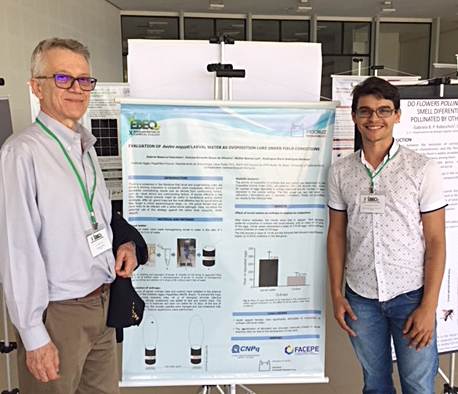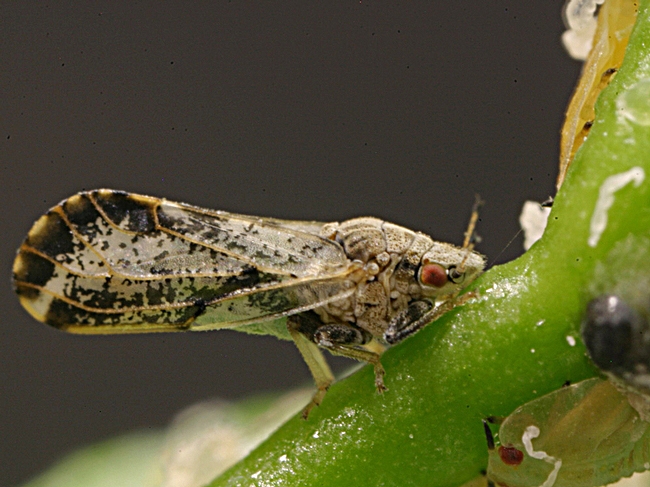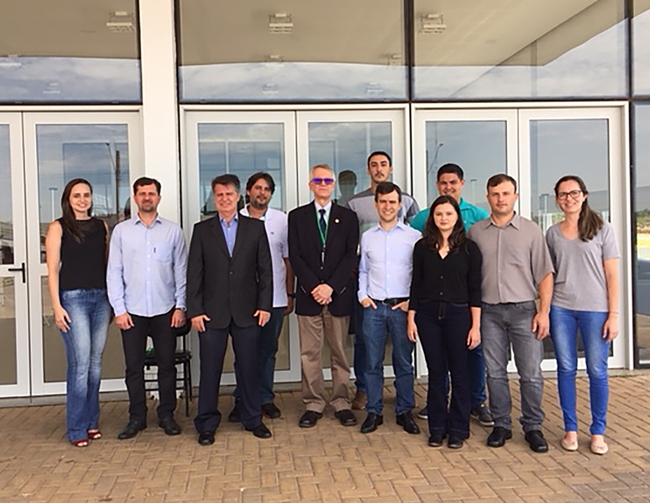
If all goes as planned, UC Davis chemical ecologist Walter Leal's discovery of the sex pheromone of the Asian citrus psyllid--which spreads the deadly citrus greening disease, Huanglongbing (HLB)--may result in the insect version of “The Fatal Attraction.”
“We are now working on a formulation to be used in traps,” Walter Leal said this week. “This might take a year, but hopefully will be ready before the flight season in California.”
Leal, who led an international team of scientists in the six-year research project, announced the discovery Dec. 5 at the 10th Annual Brazilian Meeting of Chemical Ecology in Sao Paulo. Leal is a native of Brazil and a fellow of both the Entomological Society of America and the Entomological Society of Brazil.
“The Asian citrus psyllid (ACP) is a major threat to the multibillion dollar citrus industry in the United States,” said UC Cooperative Extension advisor Surendra Dara of San Luis Obispo and Santa Barbara counties. “When an insect pest vectors a deadly disease, the threat is more serious and ACP being an invasive pest made its management even more challenging. Discovery of a sex pheromone by Dr. Leal's team is a major breakthrough not just for managing a dangerous invasive pest, but also a significant contribution to environmental sustainability. I envision this pheromone becoming a clean, green, mean weapon in the IPM arsenal against ACP.”

Joel Nelsen, president of the California Citrus Mutual, called the discovery “exciting news” and a “first step toward protecting the citrus industry. We're hoping that the next steps come in time to protect thousands of citrus growers around the country.”
“Let's move forward fast and furious,” he said, noting that the citrus industry spends millions to support the research community.
The Leal-led research team was funded solely by Fund for Citrus Protection (FUNDECITRUS).
Integrated pest management specialist Frank Zalom, distinguished professor with the UC Davis Department of Entomology and Nematology and a past president of the Entomological Society of America, hailed the discovery as a “significant breakthrough in preventing the spread of this serious citrus insect, and may offer a less toxic method for its control.” He was not involved in the study.
Kris Godfrey, associate project scientist at the UC Davis Contained Research Facility and formerly with the California Department of Food and Agriculture, agrees that better detection traps are needed. “I hope that Dr. Leal's discovery of an Asian citrus psyllid pheromone will provide the improvement in detection trapping that is needed by anyone trying to manage this insect and slow the spread of huanglongbing, a devastating disease of citrus vectored by the Asian citrus psyllid.”
Leal's Brazilian liaison, Haroldo Xavier Linhares Volpe of the Fund for Citrus Protection (FUNDECITRUS) from the state of Sao Paulo, pointed out that the discovery could “increase the ACP catches using lures with the attractive compound, leading to a more assertive, precise monitoring and could promote an early detection of ACP.”
“With a more accurate detection, we can adopt ACP integrated pest management (IPM) tools as soon as possible, avoiding or minimizing HLB spread.” He added that the lures should help decrease the population.
“However, researchers need to test all the management strategies before they are adopted,” Volpe said. “Formulation techniques need to be investigated to determine lures that release the compounds for a long time and at doses that attract the insect.”
Although ACP is present in California, the disease itself has not been established, Leal emphasized. “The emphasis is on detection, eradication and limiting the spread of the disease. In Florida, where HLB is widespread, monitoring ACP populations is essential to avoid reinfection after eradication of infected plants.” California now leads the nation in citrus production, surpassing Florida, for the first time in 70 years.
Currently growers are using yellow sticky traps to detect the insect and to monitor the population. Said Leal: “Efficient lures are sorely needed for sticky traps, particularly for early ACP detection. Otherwise, growers have to resort to regular sprays to avoid infection given that infected insects from gardens and noncommercial areas migrate to citrus farms.”
Pheromones and other semiochemicals are widely used in agriculture and medical entomology. “Growers use them as lures in trapping systems for monitoring and surveillance, as well as for strategies for controlling populations, such as mating disruption and attraction-and-kill systems,” Leal noted.
ACP feeds on new leaf growth of oranges, lemons, mandarins, grapefruit and other citrus, as well as some related plants. Infected psyllids can transmit the bacterium Candidatus Liberibacter asiaticus, which causes the fatal citrus disease. An early symptom of HLB in citrus is the yellowing of leaves on an individual limb or in a sector of a tree's canopy.
Native to Asia, ACP was first detected in the United States in June 1998 in Palm Beach County, Florida, and in California in August 2008 in San Diego County. Scientists discovered HLB in Florida in August 2005, and in Los Angeles in March 2012.
Citrus trees infected with HLB usually die within five years, according to the UC Statewide Integrated Pest Management Program. There is no known cure. “The only way to protect trees is to prevent spread of the HLB pathogen in the first place, by controlling psyllid populations and removing and destroying any infected trees,” UC IPM says on its website.
(Editor's Note: The research was published in the Jan. 11 edition of the journal Scientific Reports.)
Attached Images:
